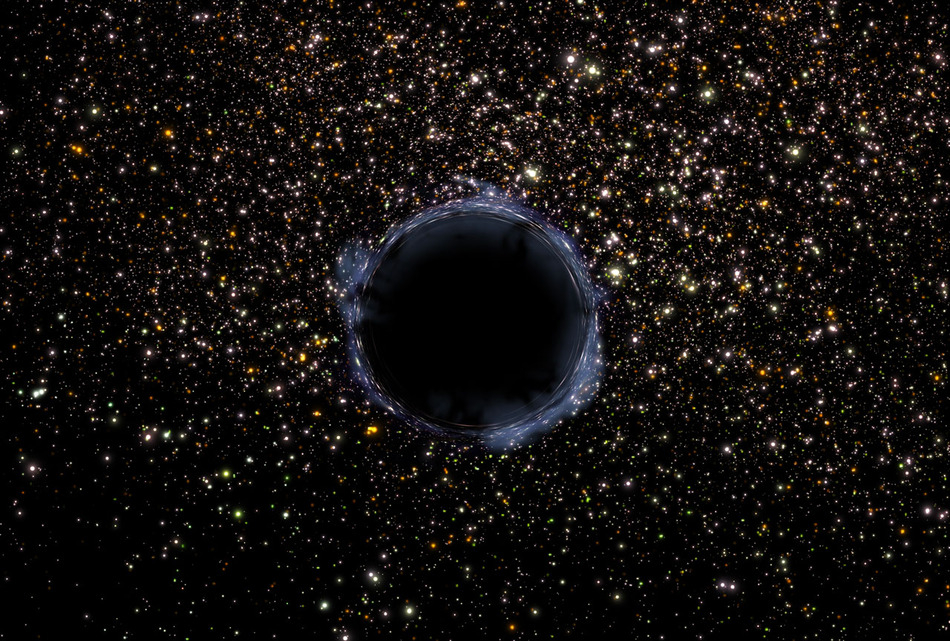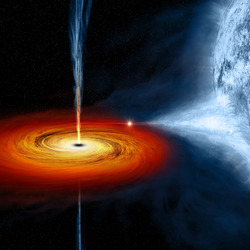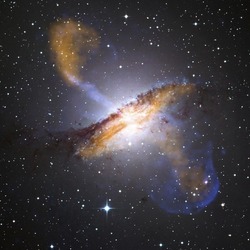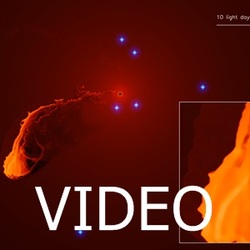
Contents
IntroductionStructure of black holes
Classification of black holes
Accretion discs and jets
Black hole Q&A section
Introduction
A black hole is an extremely massive object of relatively small dimensions. A black hole deforms space-time so strongly that it creates a real hole in space itself where nothing that has once fallen into it will ever be able to escape again. The largest known black hole lives in the centre of a galaxy called Holmberg 15A. It has a whopping mass of approximately 40 billion solar masses. In May 2020 astronomers discovered a black hole that is only 1000 light years away. It is in the Telescopium constellation and is the closest black hole to Earth. With a mass of 4 Suns it is, however, a relatively small black hole.
Structure of black holes
A black hole deforms the fabric of space around it so strongly that it creates a hole in space itself. This way nothing is able to escape from a black hole, not even light - that's why we will never be able to measure anything inside a black hole. For astronomers the only three measurable physical properties that completely specify the characteristics of a black hole are its mass, its charge and its angular momentum.
- The charge is not very important for astronomers; if the black hole had a certain charge it would attract particles of the opposite charge to neutralise itself.
- The angular momentum can be measured but we will not go into the details here. Since the angular momentum is always preserved you can expect a black hole to rotate; indeed astronomers have discovered that a black hole with the name GRS 1915+105 seems to rotate 1150 times per seconds, which is close to the theoretical upper limit.
- The mass of the black hole determines its size: the radius of its event horizon (also called the Schwarzschild radius). The event horizon is the boundary between the black hole and the outer part of space, so anything that is inside the event horizon will never be able to escape again (you can call the event horizon the "point of no return"). Any matter outside the event horizon can - at least theoretically - still escape. A good approximation for the radius of the event horizon is 3 km for each solar mass. So, a black hole with 10 solar masses has an event horizon of 30 km. The biggest known black hole of 17 billion solar masses has an event horizon of 51 billion km, or, in other words, it has a radius of about 2 light days. A (theoretical, but in reality non- existent) black hole with the mass of the moon would have a diameter of less than a tenth of a millimetre.
Classification of black holes
Astronomers distinguish four main types of black holes:
- Supermassive black holes (SMBH)
These monster black holes live in the centres of massive galaxies. Practically every massive galaxy has a supermassive black hole in its centre. Supermassive black holes can have masses between hundreds of thousands and several billion solar masses. The closest supermassive black hole to you lies 27000 light years away and has a mass of 4.3 million solar masses. This supermassive black hole is at the centre of our Milky Way. The formation of these supermassive black holes is still a subject of on-going research. However, it is agreed among scientists that once a black hole exists in the centre of a galaxy it is the seed of an emerging supermassive black hole. The initial black hole starts a process of merging with other black holes and accreting matter that falls into the black hole over billions of years of evolution, thus getting more and more massive.
By the way: supermassive black holes cannot accrete matter as fast as they want. If the inflow exceeds a certain limit (called the Eddington luminosity or Eddington limit) the radiation pressure of the ultra-luminous accretion disk is strong enough to blow away the matter further outside. In this way astronomers can explain the observed luminosities of quasars. -
Intermediate-mass black holes
Intermediate-mass black holes have masses of about 1000 solar masses and can exist in the centre of smaller galaxies or star clusters. They are rare and no intermediate-mass black hole has yet been confirmed, but some strong candidates have been discovered and may be confirmed soon. -
Stellar mass black holes
Stellar mass black holes are the most numerous amongst all types of black holes. Their masses range from about 3 to a few hundred solar masses. They are the results of supernovae, the death of massive stars (you can read more in our supernova article). Their Schwarzschild radius has just the dimensions of a smaller asteroid, typically between 10 and 100 km. There are several stellar black holes in the vicinity of our solar system - by "vicinity" we mean a few thousand light years away. They will never be able to interact in any way with our solar system. -
Micro black holes
This is a hypothetical form of a black hole that could have been created in the very early stage of the universe, shortly after the big bang, when the Universe was still very dense. That's why they are also called primordial black holes. They have not yet been discovered and their existence is just speculation. However, if they exist they are very small (of the order of the size of an atom and smaller, their event horizon is just a few nanometres) and they would have the weight of a medium sized asteroid. They would pass right through the Earth with almost no effect in less than one minute. Some research from the Max Planck Institute in Germany has revealed that a micro black hole with a mass of a billion tons would penetrate through the Earth causing minor earthquakes of magnitude 4. The form of the waves would be unique and different from all forms a normal earthquake could cause. Measuring such waves would be strong evidence for this kind of black hole. At the moment we cannot completely dismiss the possibility that these primordial black holes may even be the famous dark matter itself. But until further evidence emerges this scenario seems very unlikely.
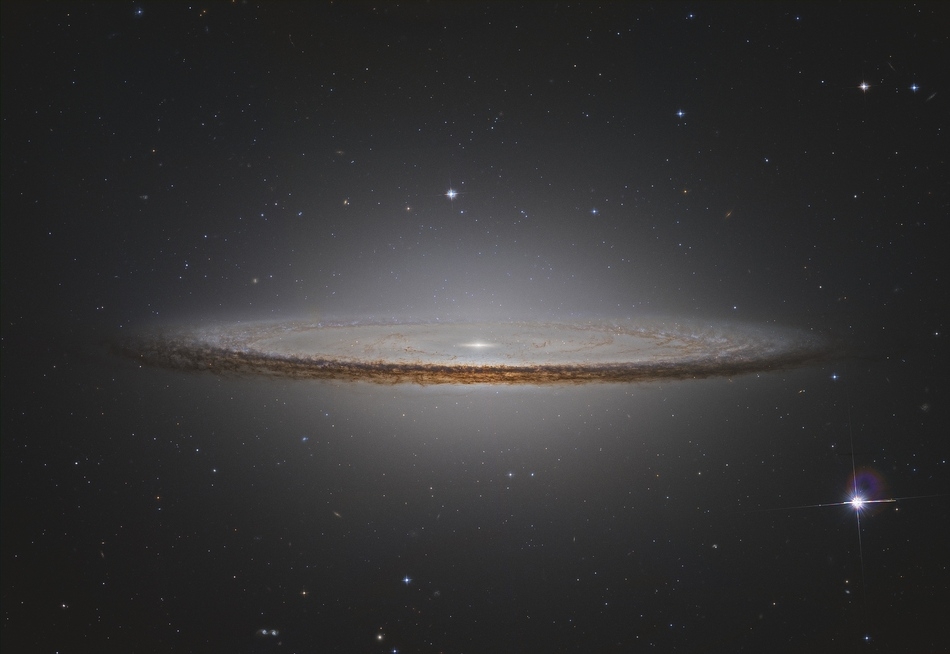 There is a supermassive black hole at the centre of the Sombrero Galaxy. Credit: Vicent Peris (OAUV/PTeam), MAST, STScI, AURA, NASA
There is a supermassive black hole at the centre of the Sombrero Galaxy. Credit: Vicent Peris (OAUV/PTeam), MAST, STScI, AURA, NASAAccretion discs and jets
Matter - mostly in the form of gas and dust clouds - that is in the vicinity of a black hole will enter an orbit around the black hole. Since the black hole is relatively small compared to the size of the infalling clouds, almost no matter falls directly into the black hole. In the proximate vicinity of the event horizon the matter forms an accretion disc which is strongly heated up by friction. The friction transports part of the angular momentum outwards, shrinking the radius of the orbiting matter to a closer radius around the black hole until a point where it finally falls into it. The potential energy released during the shrinking of the orbital radius heats up the infalling gas which can reach temperatures of tens of millions to even more than a hundred million kelvin. We will never be able to directly see a black hole, but we can detect these hot accretion disks. An accretion disk emits very strong radiation in the form of electromagnetic waves, from radio waves to X-rays (see the electromagnetic spectrum for more details). X-ray emission is the strongest of all emitted wavelengths, so we can detect black holes by observing the sky through X-rays. The processes in the accretion disk convert around 10% of the mass of the infalling matter into energy (according to E = mc2), quite a lot compared to the 0.5% to 0.7% that are emitted in the case of nuclear fusion, the process that releases almost all energy radiated by stars.
If a lot of mass is falling towards a supermassive black hole in the centre of a galaxy; these galaxies become so-called active galaxies. A brilliant example of an active galaxy is Centaurus A. Centaurus A emits two relativistic jets with emissions in X-Ray and radio wavelengths, each about 30000 light years long. Within the inner parts of these jets the matter moves at speeds of about half the speed of light. Further out the matter collides with the gas that surrounds the galaxy, creating high energy particles. What can be the reason for such an outburst of energy in the vicinity of the supermassive black hole? Most probably it's the collision of Centaurus A with a smaller spiral galaxy.
Make sure you take a look at our Q&A section about black holes!
